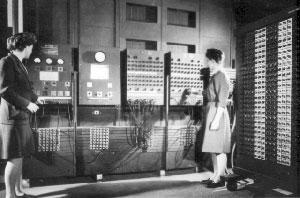
U. S. Army Photo, made available courtesy ofWikipedia and is in the public domain.
In the last half of the 20th century, the role of computation in the sciences grew rapidly, driven by advances in silicon-based processors, fiber-optic networks, a host of numerical algorithms, and sets of standard protocols for processing and exchanging data. Much of this digital technology now permeates everyday life. Building on these and emerging technologies, the 21st century is poised to unleash a new, data-intensive paradigm of scientific discovery that will dramatically enhance the scope and scale of data capture, curation, and analysis. In this new (4th) paradigm, cures for cancer might be found by the collective investigations of agents computing "in the cloud.”
This course will invite students to explore the social and technical development of computing for the sciences, from the ENIAC through the top-500 list of supercomputers and on to Amazon's EC2. Through a selection of readings, discussions with invited guests, and first-hand experimentation, students in the course will learn about an assortment of technologies that underlie modern scientific inquiry, investigate their use by U-M cyber-scientists, and gain an appreciation of the fiscal, political and social challenges imposed by this growing area of scholarship.
Instructor: August Evrard
dScribes: Kevin Smith, Sarah Sophia Na
Course Level: Undergraduate, Honors
Course Structure: Meets twice a week for 1.5 hours
Awards: 2012 Provost's Teaching Innovation Prize Winner
Learning Outcomes
Students who have taken this course should:
1. Be able to explain what computation means in the context of scientific inquiry, and provide examples of the different roles that computing plays in the sciences.
2. Be aware of the cyberinfrastructure elements that power computational science, including
- hardware, software and network components, their historical development and their mutual interactions
- data management processes, including authorization, authentication, and securitization of networked resources, and
- institutional roles, including facilities management, governance, and publication of digital assets.
3. Appreciate current challenges to scholarship associated with cyberinfrastructure, such as
- the environmental impact of large-scale computing nature of scientific publication, peer review, and career advancement
- costs, benefits and risks to research institutions.
Reading List
The textbook for this course is The Fourth Paradigm: Data-Intensive Scientific Discovery[Paperback], Eds., Tony Hey, Stewart Tansley, Kristin Tolle
The book is available for free download at www.fourthparadigm.org and it can be purchased in paperback from Amazon for $39, or $0.99 for the kindle reader version.
Publisher: Microsoft Research (October 16, 2009)
ISBN-10: 0982544200
ISBN-13: 978-0982544204
About the Creators

Gus Evrard
Gus Evrard is a Professor in the Department of Physics who specializes in Astrophysics Theory. Professor Evrard studies phenomenological problems in cosmology. As a computational cosmologist, he uses numerical methods to model the formation and evolution of large-scale cosmic structure. Universes are realized in silico using algorithms that solve the time evolution of the coupled astrophysical processes that drive the development of dark and visible matter components within large random spatial volumes. These virtual worlds are created within the framework of a particular underlying cosmology. Mock telescopic observations of galaxies and clusters of galaxies contained within this virtual environment afford the means for direct comparison to data from real-world observatories. Such comparative studies address questions ranging from the fundamental (What are the energy and matter components that dominate our universe?) to the detailed (How much material is lost by a typical galaxy over its lifetime?). Prof. Evrard was a recipient of a 2012 Provost's Teaching Innovation Prize.
- B.S. University of Pennsylvania 1981
- Ph.D. The State University of New York, Stony Brook 1986

U. S. Army Photo, made available courtesy ofWikipedia and is in the public domain.
Jump to:
| Document Title | Creator | Downloads | License |
|---|---|---|---|
|
Lecture 00 |
Gus Evrard
|
||
|
Lecture 01 |
Gus Evrard
|
||
|
Lecture 02 |
Gus Evrard
|
||
|
Lecture 03 |
Gus Evrard
|
||
|
Lecture 04 |
Gus Evrard
|
||
|
Lecture 05 |
Gus Evrard
|
||
|
Lecture 06 |
Gus Evrard
|
||
|
Lecture 07 |
Gus Evrard
|
||
|
Lecture 08 |
Gus Evrard
|
||
|
Lecture 10 |
Gus Evrard
|
||
|
Lecture 11 |
Gus Evrard
|
||
|
Lecture 12 |
Gus Evrard
|
||
|
Lecture 13 |
Gus Evrard
|
||
|
Lecture 14 |
Gus Evrard
|
||
|
Lecture 15 |
Gus Evrard
|
||
|
Lecture 16 |
Gus Evrard
|
||
|
Lecture 20 |
Gus Evrard
|
| Document Title | Creator | Downloads | License |
|---|---|---|---|
|
Whiteboard notes: 4-Node Topologies |
Gus Evrard
|
||
|
Whiteboard notes: Class Exercise |
Gus Evrard
|
||
|
Whiteboard notes: Nodes, Network Fabric |
Gus Evrard
|
||
|
Whiteboard notes: Sort-Array, Vector-Multiply |
Gus Evrard
|
||
|
Whiteboard notes: Speed, Memory, Latency |
Gus Evrard
|
||
|
Whiteboard notes: What is a Supercomputer? |
Gus Evrard
|



